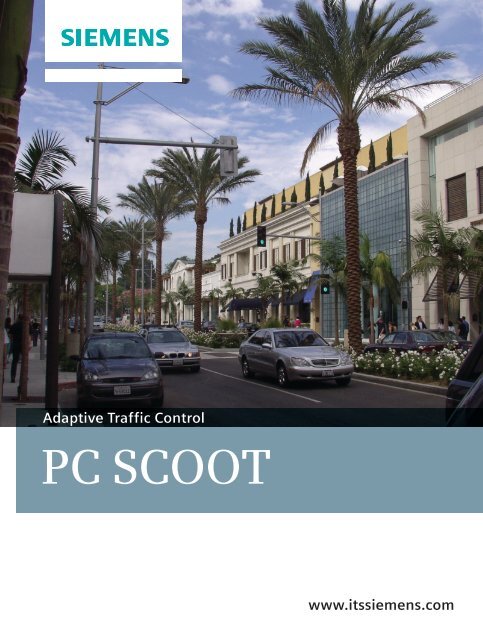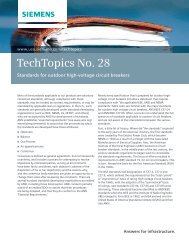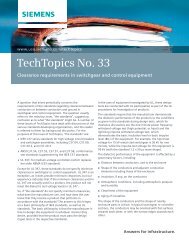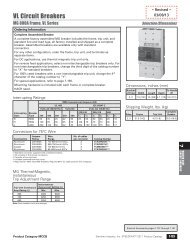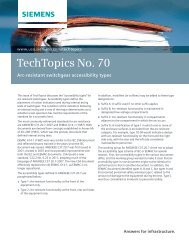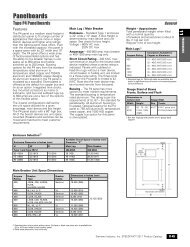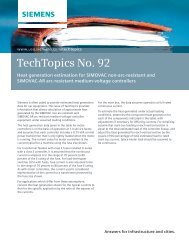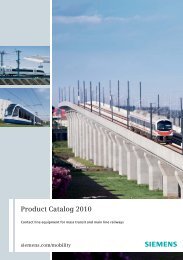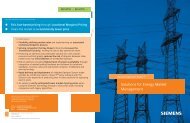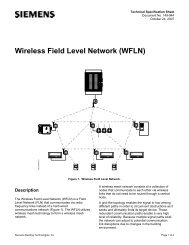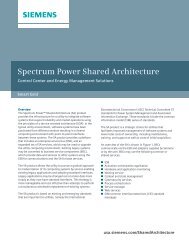PC SCOOT - Siemens
PC SCOOT - Siemens
PC SCOOT - Siemens
Create successful ePaper yourself
Turn your PDF publications into a flip-book with our unique Google optimized e-Paper software.
Adaptive Traffic Control<br />
<strong>PC</strong> <strong>SCOOT</strong><br />
www.itssiemens.com
<strong>PC</strong> <strong>SCOOT</strong> monitors<br />
traffic flow in real-time<br />
The effect of traffic congestion<br />
is an ever increasing problem in<br />
towns and cities throughout<br />
North America.<br />
The latest version of the <strong>PC</strong><br />
<strong>SCOOT</strong> adaptive traffic control<br />
software has been proven in<br />
over 100 towns and cities<br />
around the world as effective in<br />
reducing congestion and<br />
maximizing the efficiency of the<br />
road network.<br />
The successful management of traffic in the<br />
21st century places many demands upon<br />
traffic engineers and officials. As the volume of<br />
traffic on highways and roadways continues to<br />
grow at a greater rate than the capacity of the<br />
road network, the effect of traffic congestion is<br />
an ever increasing problem in towns and cities<br />
throughout North America. The traffic<br />
engineer in a modern traffic control center is<br />
continually working to maximize the efficiency<br />
of the traffic flow while minimizing any<br />
disruptions caused by incidents and events.<br />
The implementation of an effective adaptive<br />
control system benefits traffic in the town or<br />
city as well as the local economy and<br />
environment.<br />
Operating on Microsoft Windows®<br />
The latest release of the <strong>SCOOT</strong> adaptive<br />
control system – <strong>PC</strong> <strong>SCOOT</strong> – combines proven<br />
adaptive algorithms with the enhanced<br />
functionality in the user interface, all operating<br />
on a Microsoft Windows® <strong>PC</strong>-platform. This<br />
combination of <strong>Siemens</strong>’ proven <strong>SCOOT</strong><br />
software and the Microsoft Windows®<br />
operating system [OS] offers a solution which<br />
is flexible enough to meet the traffic needs of<br />
any municipality, from small towns to the<br />
largest urban metropolis.<br />
control centers<br />
• Microsoft Windows® OS<br />
• Customized congestion management tool<br />
kit<br />
• Reduced equipment and maintenance<br />
costs<br />
• Real IP communications<br />
• Maximizes network efficiency<br />
• Improved access to management data<br />
• Reductions in delay of over 20%<br />
• Ease of use for new users<br />
• Simple installation and migration<br />
Proven to reduce congenstion<br />
The latest version of the <strong>PC</strong> <strong>SCOOT</strong> adaptive<br />
traffic control software has been proven in<br />
over 100 towns and cities around the world as<br />
effective in reducing congestion and<br />
maximizing the efficiency of the road network.<br />
ITS is the keystone of urban traffic<br />
management and <strong>Siemens</strong> offers a variety of<br />
solutions ranging from a single system to a<br />
comprehensive integrated package including<br />
on-street equipment and complementary<br />
adaptive, central and regional systems<br />
networked together.<br />
<strong>PC</strong> <strong>SCOOT</strong> operates as part of a larger solution,<br />
working in tandem with other <strong>Siemens</strong><br />
advanced transportation management systems<br />
[ATMS]. The ATMS provide traffic management<br />
and control, and prepares the controller’s<br />
timing plans for interaction and adjustment by<br />
<strong>PC</strong> <strong>SCOOT</strong>.<br />
The introduction of <strong>PC</strong> <strong>SCOOT</strong> by <strong>Siemens</strong><br />
allows more cost-effective systems integration<br />
and commonality of hardware across the range<br />
of traffic management and control systems.<br />
This in turn reduces maintenance requirements<br />
and provides more opportunities for<br />
implementing a range of ITS solutions:<br />
• World leading adaptive control<br />
• Increased standardization within traffic<br />
Features that maximize efficiency<br />
ITS flexibility allows engineers to control and<br />
monitor traffic over a wide area, combining<br />
traditional traffic control with a host of<br />
additional functions to best achieve maximum<br />
efficiency:<br />
• <strong>SCOOT</strong> adaptive control<br />
• Public transport priority<br />
• Emergency vehicle green waves<br />
• Car park management and guidance
• Fixed time signal control with automatic<br />
plan selection<br />
• Traffic flow monitoring<br />
• Queue and congestion detection<br />
• Tidal flow control<br />
• Pollution monitoring<br />
Making better use of modern<br />
communication systems<br />
Modern communications technology offers a<br />
range of flexible options, which until now have<br />
not been available for adaptive control. <strong>PC</strong><br />
<strong>SCOOT</strong> has been enhanced to enable the use of<br />
modern communications technology used by<br />
ITS solutions and, in turn, absorb<br />
inconsistencies and delays in data delivery with<br />
less impact on the system. This reduces<br />
dependency on traditional leased line<br />
communications techniques and opens up the<br />
potential to utilize a wide range of modern<br />
communications technologies previously<br />
unavailable to <strong>SCOOT</strong> systems. This allows<br />
utilization of cost-effective communications<br />
infrastructures that can be optimized to<br />
individual system constraints and available<br />
infrastructure.<br />
Improving public transport priority and<br />
pedestrian movement facilities<br />
Public transport priority is increasingly seen as<br />
crucial in maintaining the effectiveness of<br />
buses and light rail systems as viable<br />
alternatives to the private car.<br />
<strong>PC</strong> <strong>SCOOT</strong> introduces several enhancements in<br />
the control of traffic signals, improving public<br />
transport priority and increasing efficiencies in<br />
dealing with pedestrian movements. Enhanced<br />
bus priority phase skipping is now included in<br />
<strong>PC</strong> <strong>SCOOT</strong>, reducing delays to buses waiting at<br />
the signals by skipping intermediate side road<br />
stages where appropriate. The system includes<br />
comprehensive guidance on when phase<br />
skipping is appropriate and when it may be<br />
inadvisable. The approach of a bus can be<br />
indicated by on-vehicle transponders<br />
activating special detectors, or the location can<br />
be provided by a bus management system<br />
using any automatic vehicle location system.<br />
On-street tests have shown benefits of up to<br />
four (4) seconds reduced delay per bus.<br />
<strong>PC</strong> <strong>SCOOT</strong> provides improved control of<br />
intelligent pedestrian facilities, using the<br />
traffic signal controller and special detectors to<br />
monitor pedestrians crossing the road and<br />
feeding this information back into the <strong>SCOOT</strong><br />
model optimizing the vehicle greens. This<br />
reduces wasted time where pedestrian<br />
crossings have long requirements for green<br />
times due to design constraints, by providing<br />
the appropriate amount of green time to<br />
pedestrians based upon detection.<br />
ITS flexibility allows engineers<br />
to control and monitor traffic<br />
over a wide area, combining<br />
traditional traffic control with<br />
a host of additional functions<br />
to best achieve maximum<br />
efficiency.
Following the introduction of <strong>SCOOT</strong>-based systems, ‘before<br />
and after’ studies have shown substantial reductions, both in<br />
journey times and delays. Vehicles are detected on all<br />
approaches to each junction under <strong>PC</strong> <strong>SCOOT</strong> control, with<br />
occupancy being measured every quarter second. This<br />
creates a profile for each link, which the <strong>SCOOT</strong> model uses<br />
to predict queue behavior at each stop line. This in turn is<br />
used in the optimization calculation. The model also predicts<br />
delays and the build-up of congestion as part of the<br />
efficiency index.<br />
<strong>PC</strong> <strong>SCOOT</strong> models traffic detected on-street to adapt three<br />
key traffic control parameters continuously – the amount of<br />
green for each approach (Split), the time between adjacent<br />
signals (Offset), and the time allowed for all approaches to a<br />
signalled intersection (Cycle time). As a result the signal<br />
timings evolve with the changing traffic situation without<br />
any of the traditional disruption caused by changing fixed<br />
time plans on other traffic control systems.<br />
Features<br />
<strong>PC</strong> <strong>SCOOT</strong> introduces a number of key new features which<br />
provide invaluable assistance to the traffic manager in<br />
maximizing the efficiency of traffic flow. A new Congestion<br />
Supervisor feature provides more early warning of<br />
congestion, as well as providing recommendations for action<br />
to reduce congestion as a result of repeatable, predictable<br />
conditions which occur within the network.<br />
The Congestion Supervisor feature continuously monitors the<br />
<strong>SCOOT</strong> network, evaluating overall performance levels and<br />
identifying congestion and wasted capacity. Where<br />
congestion levels exceed a defined threshold, the system<br />
automatically investigates the likely cause. It looks for the<br />
critical link and follows the congested route though the<br />
network, analyzing reasons for the degradation in<br />
performance and suggesting changes to system<br />
configuration to improve efficiency.<br />
The Congestion Supervisor feature uses information already<br />
available within the <strong>PC</strong> <strong>SCOOT</strong> system and does not require<br />
any additional equipment or detection. Having diagnosed a<br />
congestion problem, the recommended action to take will<br />
then be reported to the user either directly from <strong>PC</strong> <strong>SCOOT</strong> or<br />
through an integrated ATMS. Overall, the <strong>PC</strong> <strong>SCOOT</strong><br />
Congestion Supervisor feature aims to target regularly<br />
recurring congestion rather than congestion caused as a<br />
result of incidents.<br />
<strong>Siemens</strong> Industry, Inc.<br />
8004 Cameron Road<br />
Austin, Texas 78754<br />
USA<br />
Tel: +1.512.837.8300<br />
Fax: +1.512.837.0196<br />
www.itssiemens.com<br />
With a long standing history of technological innovations,<br />
renowned customer service and high quality products and<br />
services, <strong>Siemens</strong> is the leader in traffic technology products<br />
and solutions.<br />
<strong>Siemens</strong> reserves the right to alter any of the Company’s<br />
products or published technical data relating thereto at any<br />
time without notices.<br />
© 10.2011, <strong>Siemens</strong>. All rights reserved


